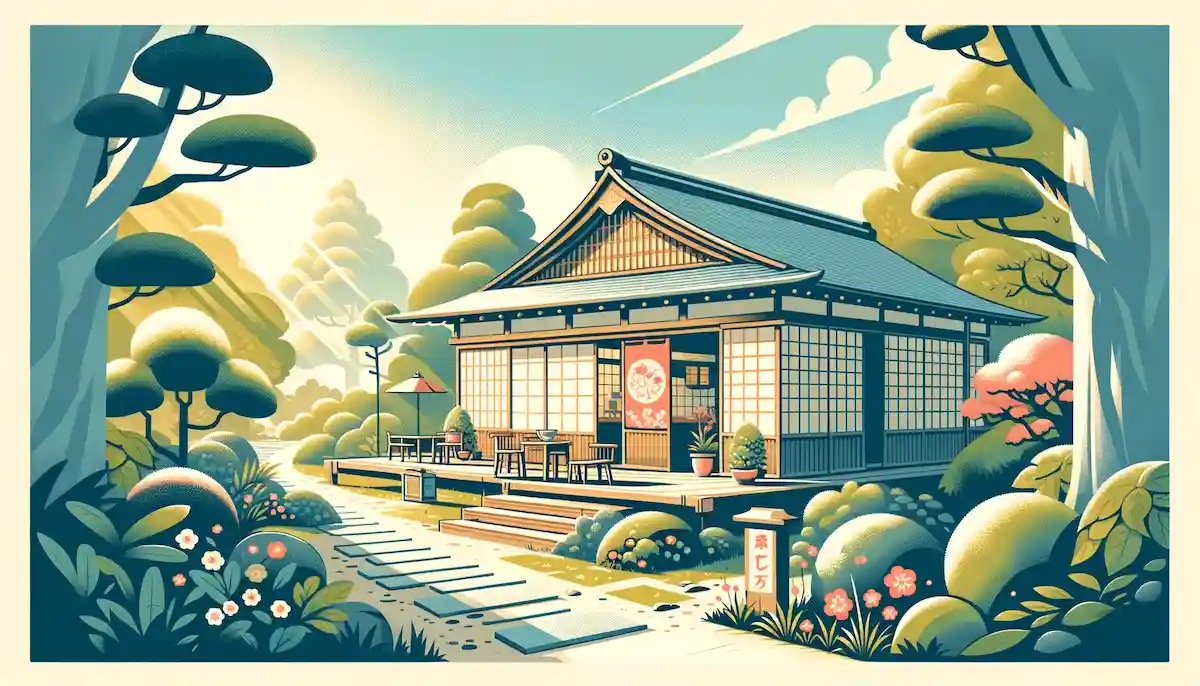古民家カフェを英語で説明・紹介するための基本情報と、英会話に役立つ表現をシンプルでわかりやすい英語で紹介します。
英会話ダイアローグ・関連情報・10の質問を通して、古民家カフェに関する英語表現を学びます。
英語
英会話ダイアローグを読む前に知っておくと良い前提知識と情報です。
- 古民家カフェとは
- 日本の伝統的な家屋や歴史的建造物を改装して作られたカフェ
- 古い木造の建築や日本庭園など、日本の伝統美を感じられる空間で、コーヒーや食事を楽しむことができる
- 地元の食材と季節感
- 古民家カフェでは、地元産の新鮮な食材を使用したメニューが特徴
- 季節に応じた食材を使い、その時期ならではの味わいを楽しむことができる
- 文化体験
- ただの飲食店ではなく、日本の伝統文化に触れることができる場所でもある
- 茶道や陶芸などのワークショップを開催しているカフェもあり、訪れる人々にとって特別な体験を提供
- 静かで落ち着いた雰囲気
- 古民家カフェは、静かで落ち着いた時間を過ごすことができる場所としても知られている
- 日常の喧騒から離れて、穏やかな時間を過ごすことができるのが魅力
古民家カフェについて話しています。
古民家カフェの魅力、地元の食材を使用した独特のメニュー、伝統的な家屋での体験、そして文化イベントやワークショップについて話題にしています。
また、古民家カフェ訪問が日本の文化を深く体験できる機会であることにも触れています。
会話 / dialogue

Hey Key, have you ever visited a Kominka Cafe here in Japan?

Yes, I’ve been to a few in Kyoto. They’re cafes set in old Japanese houses. Very serene and beautiful. Why do you ask?

I’ve heard they’re quite popular, and I’m curious to visit one. What makes them special?

Well, aside from the traditional setting, they often use local and organic ingredients. It’s a blend of old-world charm with a touch of modern cafe culture.

That sounds delightful. Do they offer any unique menu items?

Absolutely. Many offer seasonal sweets that you won’t find elsewhere, and some have unique drinks like matcha lattes or homemade fruit sodas.

Matcha latte in a traditional setting sounds like a must-try. Any recommendations?

There’s this one cafe in Kamakura, nestled in a historic area. It’s known for its tranquil garden view and exquisite matcha desserts.

Sounds like a perfect spot for a weekend getaway. Do these cafes have any activities or just food and drinks?

Some host cultural events or workshops where you can learn about Japanese traditions or even try your hand at making traditional crafts.

That would be an incredible experience. Combining cultural learning with a relaxing cafe atmosphere.

Exactly. It’s more than just a cafe visit; it’s about immersing yourself in Japanese culture and enjoying the moment.

I’m definitely adding a 古民家カフェ to my list. Thanks for the insights, Key!

No problem, Mack. You’ll love the experience. Let’s plan a visit together sometime!
関連情報 / related information
「古民家カフェ」について、理解を深めるための「英語での関連情報」です。
古民家カフェ

Introduction to Kominka Cafes
Kominka Cafes are unique cafes in Japan that use old traditional houses for their settings. These places are popular for their historic charm and the way they blend traditional Japanese culture with modern cafe culture. Visitors can enjoy a cozy atmosphere while sipping on their favorite drinks.
Menu and Ingredients
Kominka Cafes offer a variety of drinks and foods, focusing on using local and seasonal ingredients. From classic coffee and tea to Japanese sweets and light meals, the menu reflects a commitment to quality and tradition. Some cafes also offer unique dishes that you can’t find anywhere else.
Cultural Experience
Besides eating and drinking, Kominka Cafes often host cultural events and workshops. These can include tea ceremonies, calligraphy classes, or crafting traditional Japanese items. It’s a great way to dive deeper into Japanese culture while enjoying a relaxing cafe visit.
Why Visit a Kominka Cafe?
Visiting a Kominka Cafe is more than just going out for coffee. It’s an opportunity to slow down and appreciate the beauty of traditional Japanese architecture and design. For anyone interested in Japanese culture or looking for a peaceful spot to relax, a Kominka Cafe is a must-visit destination.
10の質問 / 10 questions
「古民家カフェ」について、理解を深めるための「英語での10の質問」です。
1: What is a Kominka Cafe?
A Kominka Cafe is a cafe in Japan located in a traditional Japanese house. It combines old Japanese architecture with a modern cafe atmosphere.
2: Why are Kominka Cafes popular?
They are popular because they offer a unique experience where visitors can enjoy traditional Japanese beauty in a cozy and peaceful setting.
3: What can you expect to see inside a Kominka Cafe?
Inside, you might see tatami mats, low wooden tables, sliding doors, and other traditional Japanese decorations that create a warm atmosphere.
4: What types of food and drinks do Kominka Cafes serve?
Kominka Cafes usually serve coffee, tea, Japanese sweets, and sometimes light meals using local ingredients.
5: Do Kominka Cafes offer any activities?
Yes, some Kominka Cafes have workshops or cultural events, such as tea ceremonies, pottery, and calligraphy classes.
6: Where are Kominka Cafes usually located?
Many Kominka Cafes are located in areas with historical or cultural significance, like Kyoto, Kamakura, and rural parts of Japan.
7: Can you visit a Kominka Cafe in all seasons?
Yes, and each season offers a unique experience. For example, cherry blossoms in spring, green leaves in summer, colorful leaves in autumn, and snow in winter.
8: How does a visit to a Kominka Cafe feel?
It feels relaxing and peaceful. The traditional setting and quiet environment help visitors enjoy a slower pace away from the city.
9: What kind of people visit Kominka Cafes?
People who want to experience Japanese culture, enjoy traditional architecture, or seek a quiet, peaceful place often visit Kominka Cafes.
10: Are Kominka Cafes suitable for tourists?
Yes, they are great for tourists who want to learn about Japanese culture and enjoy a unique experience in a traditional Japanese setting.
和訳付
会話 / dialogue

Hey Key, have you ever visited a Kominka Cafe here in Japan?
ねえ、Key、日本で古民家カフェに行ったことある?

Yes, I’ve been to a few in Kyoto. They’re cafes set in old Japanese houses. Very serene and beautiful. Why do you ask?
うん、京都でいくつか行ったよ。古い日本の家を利用したカフェだよ。とても静かで美しい。どうして聞くの?

I’ve heard they’re quite popular, and I’m curious to visit one. What makes them special?
かなり人気があると聞いたんだけど、訪れてみたいと思っている。何がそんなに特別なの?

Well, aside from the traditional setting, they often use local and organic ingredients. It’s a blend of old-world charm with a touch of modern cafe culture.
まぁ、伝統的な設定はさておき、地元の有機食材をよく使うんだ。古き良き魅力と現代のカフェ文化が融合しているんだよ。

That sounds delightful. Do they offer any unique menu items?
それは素敵だね。ユニークなメニュー項目はあるの?

Absolutely. Many offer seasonal sweets that you won’t find elsewhere, and some have unique drinks like matcha lattes or homemade fruit sodas.
もちろん。他では見つからない季節のスイーツを提供しているところが多いし、抹茶ラテや手作りのフルーツソーダのようなユニークなドリンクを提供しているところもあるよ。

Matcha latte in a traditional setting sounds like a must-try. Any recommendations?
伝統的な設定での抹茶ラテは試す価値がありそうだね。おすすめはある?

There’s this one cafe in Kamakura, nestled in a historic area. It’s known for its tranquil garden view and exquisite matcha desserts.
鎌倉の歴史的なエリアにあるカフェがあるんだ。静かな庭園の眺めと絶品の抹茶デザートで知られているよ。

Sounds like a perfect spot for a weekend getaway. Do these cafes have any activities or just food and drinks?
週末の小旅行にぴったりの場所に聞こえるね。これらのカフェには、食事やドリンク以外に何かアクティビティはあるの?

Some host cultural events or workshops where you can learn about Japanese traditions or even try your hand at making traditional crafts.
文化イベントやワークショップを開催しているところもあって、日本の伝統について学んだり、伝統的な工芸品を作ってみることもできるよ。

That would be an incredible experience. Combining cultural learning with a relaxing cafe atmosphere.
それは素晴らしい体験になりそうだね。文化学習とリラックスできるカフェの雰囲気を組み合わせているんだ。

Exactly. It’s more than just a cafe visit; it’s about immersing yourself in Japanese culture and enjoying the moment.
その通り。ただのカフェ訪問以上のことで、日本の文化に浸りながらその瞬間を楽しむことについてなんだ。

I’m definitely adding a 古民家カフェ to my list. Thanks for the insights, Key!
絶対に古民家カフェをリストに加えるよ。情報をありがとう、Key!

No problem, Mack. You’ll love the experience. Let’s plan a visit together sometime!
いいよ、Mack。その体験、気に入るはずだよ。いつか一緒に訪れる計画を立てよう!
関連情報 / related information
古民家カフェ

Introduction to Kominka Cafes
Kominka Cafes are unique cafes in Japan that use old traditional houses for their settings. These places are popular for their historic charm and the way they blend traditional Japanese culture with modern cafe culture. Visitors can enjoy a cozy atmosphere while sipping on their favorite drinks.
古民家カフェとは、日本の伝統的な古い家を使って設定されたユニークなカフェです。これらの場所は、歴史的な魅力と、伝統的な日本文化と現代のカフェ文化とを融合させた方法で人気があります。訪問者は、お気に入りのドリンクを楽しみながら、居心地の良い雰囲気を楽しむことができます。
Menu and Ingredients
Kominka Cafes offer a variety of drinks and foods, focusing on using local and seasonal ingredients. From classic coffee and tea to Japanese sweets and light meals, the menu reflects a commitment to quality and tradition. Some cafes also offer unique dishes that you can’t find anywhere else.
古民家カフェでは、地元の旬の食材を使用することに焦点を当てた、さまざまなドリンクや食品を提供しています。クラシックなコーヒーやお茶から日本のスイーツ、軽食に至るまで、メニューは品質と伝統へのこだわりを反映しています。一部のカフェでは、他では見つからないユニークな料理も提供しています。
Cultural Experience
Besides eating and drinking, Kominka Cafes often host cultural events and workshops. These can include tea ceremonies, calligraphy classes, or crafting traditional Japanese items. It’s a great way to dive deeper into Japanese culture while enjoying a relaxing cafe visit.
食事や飲み物の提供だけでなく、古民家カフェではしばしば文化イベントやワークショップが開催されます。これには、茶道、書道クラス、または伝統的な日本のアイテムの製作が含まれることがあります。リラックスしたカフェ訪問を楽しみながら、日本文化をより深く探求する素晴らしい方法です。
Why Visit a Kominka Cafe?
Visiting a Kominka Cafe is more than just going out for coffee. It’s an opportunity to slow down and appreciate the beauty of traditional Japanese architecture and design. For anyone interested in Japanese culture or looking for a peaceful spot to relax, a Kominka Cafe is a must-visit destination.
古民家カフェを訪れることは、単にコーヒーを飲みに行く以上のものです。それは、伝統的な日本の建築やデザインの美しさをゆっくりと味わう機会です。日本文化に興味がある人や、リラックスできる静かな場所を探している人にとって、古民家カフェは訪れるべき目的地です。
10の質問 / 10 questions
1: What is a Kominka Cafe?
古民家カフェとは何ですか?
A Kominka Cafe is a cafe in Japan located in a traditional Japanese house. It combines old Japanese architecture with a modern cafe atmosphere.
古民家カフェは、伝統的な日本家屋にあるカフェで、古い日本の建築と現代のカフェの雰囲気を融合させた場所です。
2: Why are Kominka Cafes popular?
なぜ古民家カフェは人気があるのですか?
They are popular because they offer a unique experience where visitors can enjoy traditional Japanese beauty in a cozy and peaceful setting.
古民家カフェは、居心地の良い静かな空間で日本の伝統美を楽しむ独特の体験を提供するため、人気があります。
3: What can you expect to see inside a Kominka Cafe?
古民家カフェの中には何があるのですか?
Inside, you might see tatami mats, low wooden tables, sliding doors, and other traditional Japanese decorations that create a warm atmosphere.
中には、畳、低い木製のテーブル、障子など、温かい雰囲気を作る日本の伝統的な装飾が見られます。
4: What types of food and drinks do Kominka Cafes serve?
古民家カフェではどんな食べ物や飲み物が提供されますか?
Kominka Cafes usually serve coffee, tea, Japanese sweets, and sometimes light meals using local ingredients.
古民家カフェでは、コーヒーやお茶、日本のスイーツ、そして時には地元の食材を使った軽食が提供されます。
5: Do Kominka Cafes offer any activities?
古民家カフェでは何かアクティビティがありますか?
Yes, some Kominka Cafes have workshops or cultural events, such as tea ceremonies, pottery, and calligraphy classes.
はい、一部の古民家カフェでは、茶道や陶芸、書道クラスなどのワークショップや文化イベントが開催されます。
6: Where are Kominka Cafes usually located?
古民家カフェは通常どこにありますか?
Many Kominka Cafes are located in areas with historical or cultural significance, like Kyoto, Kamakura, and rural parts of Japan.
多くの古民家カフェは、京都や鎌倉、田舎のような歴史的または文化的に重要な場所にあります。
7: Can you visit a Kominka Cafe in all seasons?
古民家カフェはどの季節でも訪れることができますか?
Yes, and each season offers a unique experience. For example, cherry blossoms in spring, green leaves in summer, colorful leaves in autumn, and snow in winter.
はい、そして各季節で異なる体験ができます。たとえば、春は桜、夏は緑の葉、秋は紅葉、冬は雪景色が楽しめます。
8: How does a visit to a Kominka Cafe feel?
古民家カフェを訪れるとどんな気持ちになりますか?
It feels relaxing and peaceful. The traditional setting and quiet environment help visitors enjoy a slower pace away from the city.
リラックスして平和な気分になります。伝統的な空間と静かな環境が、都会から離れてゆっくりとした時間を楽しむのに役立ちます。
9: What kind of people visit Kominka Cafes?
古民家カフェにはどんな人が訪れますか?
People who want to experience Japanese culture, enjoy traditional architecture, or seek a quiet, peaceful place often visit Kominka Cafes.
日本文化を体験したい人、伝統的な建築を楽しみたい人、または静かで落ち着いた場所を求める人がよく訪れます。
10: Are Kominka Cafes suitable for tourists?
古民家カフェは観光客に向いていますか?
Yes, they are great for tourists who want to learn about Japanese culture and enjoy a unique experience in a traditional Japanese setting.
はい、日本文化を学び、伝統的な日本の空間で特別な体験を楽しみたい観光客にとって最適です。
words & phrases
英会話ダイアローグと関連情報に出てきた単語・フレーズです(例文は各3つ)。

serene: 形容詞
意味: 穏やかな、平和な。Calm, peaceful, and untroubled.
(古民家カフェの周りの穏やかな環境や雰囲気を指す)
例文:
The serene landscape of the countryside brings me peace.
「田舎の穏やかな風景が私に平和をもたらします。」
She looked serene despite the chaos around her.
「彼女は周りが混沌としていても穏やかな表情をしていました。」
A serene atmosphere is what I seek in a vacation.
「休暇で求めるのは穏やかな雰囲気です。」
nestle: 動詞
意味: くっついて寄り添う、隠れるように位置する。To lie comfortably close to or against something.
例文:
The cottage is nestled in the heart of the forest.
「その小屋は森の中心に隠れるように位置しています。」
A small village nestled among the mountains.
「山々に囲まれた小さな村。」
The cafe nestled in the historic area attracts many visitors.
「歴史的なエリアに位置するカフェは多くの訪問者を引き付けます。」
tranquil: 形容詞
意味: 静かで平和な。Free from disturbance; calm.
(古民家カフェの静かで平和な雰囲気を指す)
例文:
He found a tranquil spot in the garden to read.
「彼は庭で読書をするための静かな場所を見つけました。」
The tranquil sound of the river soothed my mind.
「川の静かな音が私の心を和ませました。」
A tranquil morning in the countryside is my ideal start to the day.
「田舎の静かな朝は、一日の理想的な始まりです。」
exquisite: 形容詞
意味: 非常に美しい、精巧な。Extremely beautiful and delicate.
(古民家カフェのメニューや内装の洗練された美しさを指す)
例文:
She wore an exquisite dress to the party.
「彼女はパーティーに非常に美しいドレスを着て行きました。」
The chef prepared an exquisite meal that delighted all our senses.
「シェフは私たちの感覚を喜ばせる精巧な食事を用意しました。」
The gallery displayed exquisite pieces of art from around the world.
「そのギャラリーは世界中から集められた精巧な芸術作品を展示していました。」
getaway: 名詞
意味: 逃避行、休暇。A short holiday or escape.
(週末や短期休暇で訪れる古民家カフェでのリラックスした時間を指す)
例文:
We’re planning a weekend getaway to the countryside.
「私たちは週末に田舎への短い休暇を計画しています。」
The mountain cabin is the perfect getaway for those seeking tranquility.
「その山小屋は静けさを求める人々にとって完璧な逃避行の場所です。」
A tropical island is my ideal getaway destination.
「熱帯の島は私の理想的な休暇先です。」
insight: 名詞
意味: 洞察力、理解。The capacity to gain an accurate and deep understanding.
(古民家カフェに関する深い理解や知識を指す)
例文:
Her book offers great insights into traditional Japanese culture.
「彼女の本は、伝統的な日本文化に関する素晴らしい洞察を提供します。」
The documentary provided insight into the lives of people in remote areas.
「そのドキュメンタリーは、遠隔地の人々の生活に対する洞察を提供しました。」
Gaining insight into customer behavior is crucial for our marketing strategy.
「顧客の行動に対する洞察を得ることは、私たちのマーケティング戦略にとって重要です。」
settings: 名詞
意味: 環境、設定。The place or type of surroundings where something is positioned or where an event takes place.
(古民家カフェのような特定の場所やその雰囲気を指す)
例文:
The settings of the movie are in a small coastal town.
「その映画の舞台は小さな沿岸の町です。」
Changing the settings on your camera can improve the photo quality.
「カメラの設定を変更することで写真の品質を向上させることができます。」
I love the peaceful settings of traditional Japanese gardens.
「私は伝統的な日本庭園の平和な環境が大好きです。」
cozy: 形容詞
意味: 快適で居心地の良い。Comfortable, warm, and inviting.
(古民家カフェの内装や雰囲気が提供する心地よさを指す)
例文:
The room was decorated to be cozy and welcoming.
「その部屋は快適で歓迎されるように装飾されました。」
On a cold night, there’s nothing better than a cozy blanket.
「寒い夜には、快適な毛布ほど良いものはありません。」
We found a cozy little cafe to spend the afternoon.
「私たちは午後を過ごすために居心地の良い小さなカフェを見つけました。」
